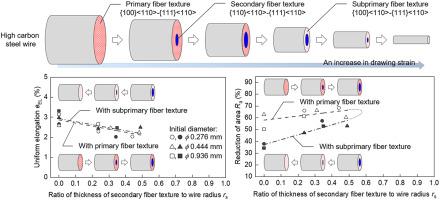Materials Science and Engineering: A ( IF 6.4 ) Pub Date : 2020-09-18 , DOI: 10.1016/j.msea.2020.140283 Shiori Gondo , Rena Tanemura , Ryuki Mitsui , Satoshi Kajino , Motoo Asakawa , Kosuke Takemoto , Kenichi Tashima , Shinsuke Suzuki

|
This study describes the evolution of a mesoscale structure that was characterized using fiber textures and mechanical properties versus drawing strain up to the drawing limit: the wire was drawn without causing rupturing, for the drawn high carbon steel wires (initial diameters: 0.276, 0.444 and 0.936 mm). Crystal orientation analysis using an electron backscatter diffraction pattern showed that the evolution of the mesoscale structure followed four steps with increasing drawing strain, regardless of the initial wire diameter. First, the wire consisted of only a primary fiber texture {100}<110>−{111}<110>. Second, the wire had primary and secondary {110}<110>−{111}<110> fiber textures in the outer and inner sides, respectively. Third, the wire had subprimary {100}<110>−{111}<110> and secondary fiber textures in its outer and inner sides, respectively. Fourth, the wire only consisted of a subprimary fiber texture. Results obtained through tensile testing showed that uniform elongation increased but the reduction of area decreased as the initial diameter increased over the entire drawing strain range, when there were no differences in lamellar spacing and tensile strength for the patented wires. Furthermore, uniform elongation decreased but the reduction of area increased when the ratio of thickness of secondary fiber texture to the wire radius increased. This study suggested that maintaining the thickness of secondary fiber texture in a large drawing strain region contributes to the improvement of drawability.
中文翻译:

拉拔高碳钢丝的中尺度组织与延展性的关系
这项研究描述了一种中尺度结构的演变过程,该过程的特征在于纤维的质地和机械性能与直至拉伸极限的拉伸应变:对于拉伸的高碳钢丝(初始直径:0.276、0.444和0.936毫米)。使用电子反向散射衍射图样的晶体取向分析表明,中尺度结构的演变遵循四个步骤,且拉伸应变增加,而与初始线径无关。首先,导线仅由主纤维纹理{100} <110>-{111} <110>组成。其次,金属丝的外侧和内侧分别具有主要的{110} <110>-{111} <110>和次要的纤维纹理。第三,导线具有次级{100} <110>-{111} <110> 次级纤维纹理分别在其外侧和内侧。第四,金属丝仅由次要纤维质地组成。通过拉伸试验获得的结果表明,当专利线材的层间距和拉伸强度没有差异时,随着初始直径的增加,均匀伸长率增加,但面积减小却减小。此外,当二次纤维织构的厚度与线半径的比率增加时,均匀伸长率降低,但是面积减小增加。这项研究表明,在较大的拉伸应变区域内保持二次纤维织构的厚度有助于改善拉伸性。通过拉伸试验获得的结果表明,当专利线材的层间距和拉伸强度没有差异时,随着初始直径的增加,均匀伸长率增加,但面积减小却减小。此外,当二次纤维织构的厚度与线半径的比率增加时,均匀伸长率降低,但是面积减小增加。这项研究表明,在较大的拉伸应变区域内保持二次纤维织构的厚度有助于改善拉伸性。通过拉伸试验获得的结果表明,当专利线材的层间距和拉伸强度没有差异时,随着初始直径的增加,均匀伸长率增加,但面积减小却减小。此外,当二次纤维织构的厚度与线半径的比率增加时,均匀伸长率降低,但是面积减小增加。这项研究表明,在较大的拉伸应变区域内保持二次纤维织构的厚度有助于改善拉伸性。当专利线的层间距和拉伸强度没有差异时。此外,当二次纤维织构的厚度与线半径的比率增加时,均匀伸长率降低,但是面积减小增加。这项研究表明,在较大的拉伸应变区域内保持二次纤维织构的厚度有助于改善拉伸性。当专利线的层间距和拉伸强度没有差异时。此外,当二次纤维织构的厚度与线半径的比率增加时,均匀伸长率降低,但是面积减小增加。这项研究表明,在较大的拉伸应变区域内保持二次纤维织构的厚度有助于提高可拉伸性。


























 京公网安备 11010802027423号
京公网安备 11010802027423号